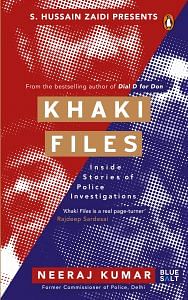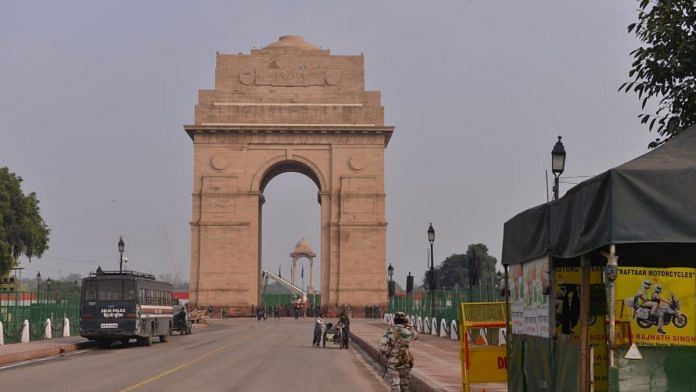On 19 February, when we were clueless, out of our depth and running out of time, a saviour arrived on the scene in late afternoon. He was neither a cop nor a computer whiz-kid nor a cryptologist. He was an unemployed youth who had come looking for a job in Delhi. He had nowhere to go except to Pramod (ACP Pramod Kushwaha), who had been his senior in school. Vivek Thakur was his name. Vivek could sense that things weren’t right with his schoolmate, who had anxiety writ large on his face. Vivek inquired what the matter was. Without giving him any background information, Pramod told him that he was struggling with an encrypted message that could not be deciphered. On Vivek’s request, Pramod shared the coded messages with him. Thereafter, Pramod left the office to seek help from diverse sources to decode the messages.
After a couple of hours, Pramod returned to his office, drained after what he felt was another wasted day of fruitless work. He found Vivek still sitting on the visitor’s couch with pen and paper, working on the code. Pramod expressed his surprise on seeing him. Vivek looked up at him and said: ‘Sir, I think I should be able to crack it.’ Pramod brushed him aside saying a job was not done until it was done. Vivek, however, persevered with the code, mindless of Pramod’s dismissive comment.
At this point, I sent Pramod a message that I wished to see him. I wanted to meet him to review the progress on the case.
The ACP left his office in Ashok Vihar for police headquarters, where my office was located. Vivek wanted to accompany him as he thought that at the end of the forty-minute drive to headquarters, he would have cracked the code. Reluctantly, Pramod agreed. Throughout the long drive amidst maddening traffic, the two friends did not exchange a word. Vivek remained drowned in thought, scribbling feverishly on a sheet of paper.
As they alighted near the stairs of the police headquarters, Vivek, in a eureka moment, let out a muted cry of triumph: ‘Sir, I have cracked the code and it is very simple. It is a combination of binary and decimal systems that our maths teacher in school taught us.’
Pramod began to climb the stairs and heard Vivek out with incredulity. His friend explained that each letter of the English alphabet had been numbered from .0 to .9, starting with A. The tenth letter was numbered 00, with the decimal point shifting a digit to the left. So, A was numbered .0, B was .1, C was .2 and so on until J, which was numbered .9. With this method, K was not assigned the number .10 but instead .00, and L became .01, M was .02 and so on until T, which was numbered .09. Consequently, U was numbered .000, V was .001, W was .002, X was .003, Y was .004 and Z was .005.
To further clarify, I will put it down more elaborately. The code used for each letter of the alphabet is written below it:
A B C D E F G H I J K L M N
0 .1 .2 .3 .4 .5 .6 .7 .8 .9 00 .01 .02 .03
O P Q R S T U V W X Y Z
.04 .05 .06 .07 .08 .09 000 .001 .002 .003 .004 .005
In some emails, -5 or -7 was written at the end of the code. That meant that while decoding, the reader needed to count back those many letters. For instance, the email dated 17 February read:
‘Dear Rashid, please make a new email ID. Then mail me on my present ID 002 .1 .004 .7 .09 .7 .07 .7 .000 – 7’. Using this method, 002 was X, but if we counted back seven letters (as indicated by ‘-7’ at the end of the message), it became P. The deciphered code therefore read ‘purana makan’. It was not surprising, therefore, that emails sent after 17 February originated from puranamakan@hotmail.com. The matching of this email ID confirmed that this indeed was the correct way to decode the messages.
While both schoolmates sat outside my office waiting for their turn to see me, Pramod once again made sure that the decoding formula worked out by Vivek was in order. When Pramod walked into my office he looked triumphant and relaxed. He explained the decoding methodology to me, and we were finally able to make sense of the coded emails. We then realized that India Gate was going to be the target of an attack, as mentioned in code in the email dated 15 February. The coded message, as stated earlier, was ‘.05 .000 .00 .05.7.03 .7 .0 .4 -7’. When decoded, it read ‘India Gatx’. The last letter was a typo and ‘x’ was meant to be ‘e’.
Therefore, the date for the terror attack was fixed as 25 February and the target was India Gate.
The email dated 18 February read ‘Chacha bird will come two days before time Zak’.
Alarmingly, the next message, dated 21 February 2003, came from a new email ID, sundarbhXXXa_hindu@hotmail.com, and it was addressed to puranamakan@hotmail.com.
It read:
Brother. Assalam waley kum.
Bhai main aaj hi Sri . . . se del.. aa gaya hun. Uss aadmi
se raabta karke aapko khabar karta hun.
Sundar
[Brother, God be with you. I have reached Del.. from
Sri . . . today. Once I have established contact with him
I will get back to you. Sundar]
This email was cause for further panic as it indicated that the plan was now in its final stages and someone had come from Srinagar to Delhi to ensure its successful execution.
The first thing I did was to inform my superior, the commissioner of police, Delhi. I suggested to him that the higher-ups in the government should be informed immediately, which he promptly did. Those readers who hail from Delhi and have visited India Gate would know that there was a time when a visitor could walk right up to the base of the monument. In the days before the new security system was imposed, milling crowds of men, women and children thronged the area around India Gate, along with ice cream and snack vendors. At any given point, a minimum of four to five thousand people were present there. From a terrorist group’s viewpoint, what better target could there be than this, and that too at an iconic war memorial? The impact would have been as earth-shattering as the earlier attack on the Parliament House in 2001.
I clearly remember that on 22 February, I was summoned to a midnight meeting at the residence of the then home minister, L.K. Advani. The heads of various intelligence agencies, the home secretary and yours truly attended the meeting. I was asked to brief everyone present on the sequence of events and what needed to be done by the government. I showed to all present the encrypted messages, their decoded versions and the clear indications of an imminent terror strike at India Gate, as concealed in the emails exchanged. At the end of my presentation it was clear to all that there was an urgent need to deploy sufficient armed forces at India Gate. Without much ado, the decision was made to not take any chances and to make a show of our response. A detachment of the Indian Army was to be deployed immediately.
When the next day broke, early morning joggers on Rajpath were surprised to see army men wielding light machine guns stationed all around India Gate in full battle gear. A few light tanks were also stationed at strategic points for effect.
My sense is that the terrorists probably went to ‘play’ the ‘World Cup’, but seeing the army deployment there, quietly retreated. The exchange of emails stopped completely, which corroborated this inference. A major terror event had been averted and many lives saved. No one will know what effect such a terror attack would have had on Indo-Pak relations, which were fragile at the time in the aftermath of the Parliament House attack that had brought the armies of the two neighbours eyeball to eyeball.
 This excerpt from Khaki Files: Inside Stories of Police Investigations by Neeraj Kumar has been published with permission from Penguin Random House India.
This excerpt from Khaki Files: Inside Stories of Police Investigations by Neeraj Kumar has been published with permission from Penguin Random House India.



